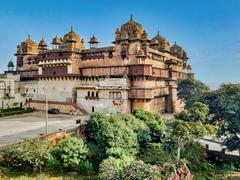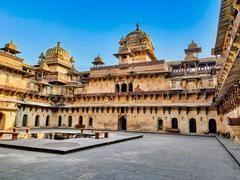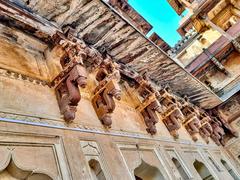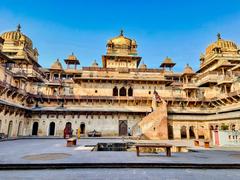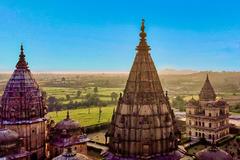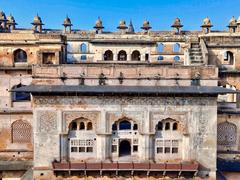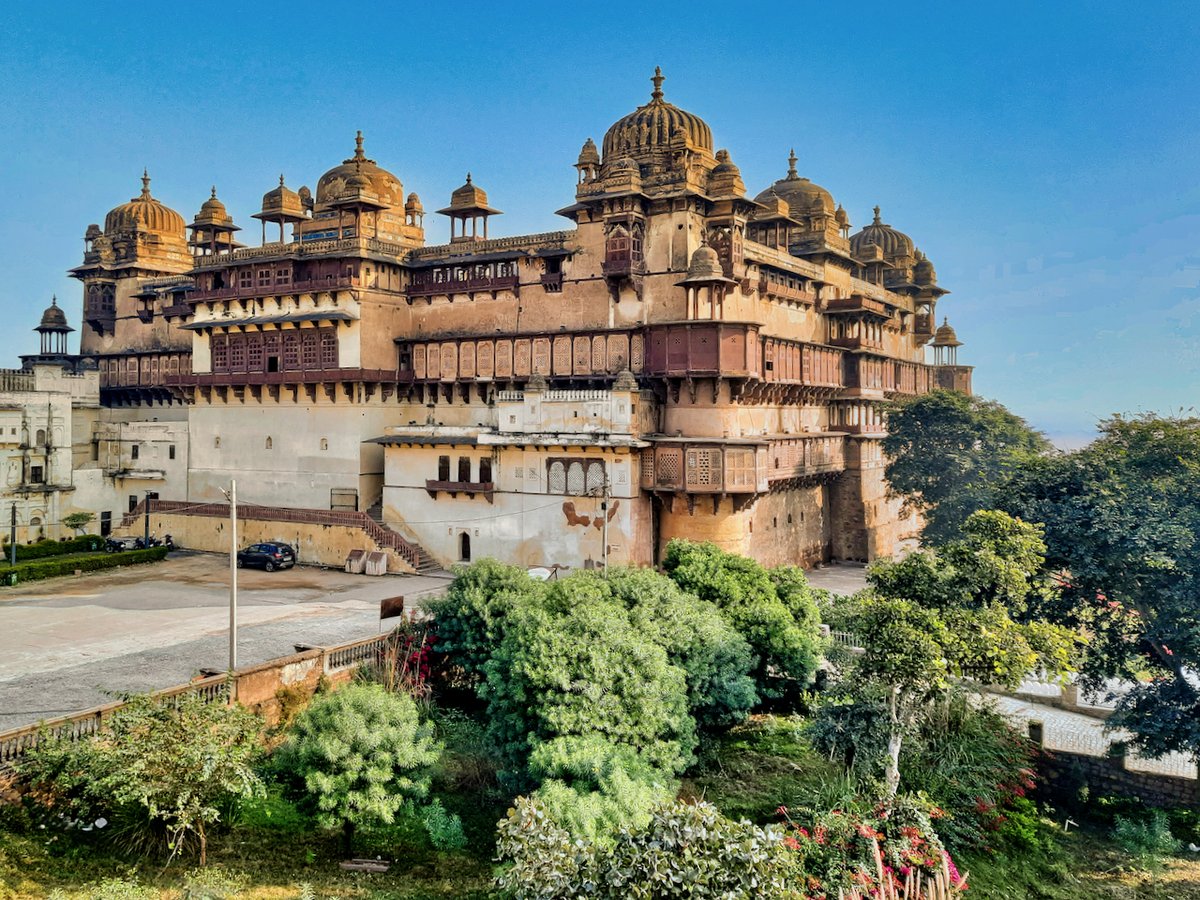
Jahangir Mahal Visiting Hours, Tickets, and Complete Guide to Orchha’s Historical Gem
Date: 14/06/2025
Introduction
Jahangir Mahal, a crowning jewel in the historic town of Orchha, Madhya Pradesh, is a masterpiece of Indo-Islamic architecture and a living testament to India’s rich cultural legacy. Commissioned in the early 17th century by Maharaja Bir Singh Deo of the Bundela dynasty to commemorate Mughal Emperor Jahangir’s visit, this palace represents a harmonious blend of Mughal and Rajput styles. Perched above the Betwa River, Jahangir Mahal offers panoramic vistas and stands as a symbol of political diplomacy, strategic foresight, and artistic brilliance. Today, it is a prime attraction for tourists and scholars eager to explore Orchha’s layered history.
Table of Contents
- Historical Background
- Visitor Information
- Travel Tips and Nearby Attractions
- On-Site Experience
- Frequently Asked Questions (FAQ)
- Visuals and Media
- Conclusion
- References
Historical Background
Origins and Construction
Jahangir Mahal was constructed between 1605 and 1627 CE by Maharaja Bir Singh Deo as a monumental palace to honor Emperor Jahangir’s first visit to Orchha. This act was a calculated move to solidify a strategic alliance with the Mughal Empire, underscoring Orchha’s political acumen and desire for stability in a turbulent era. The palace’s construction blends the ornate sensibilities of the Bundela Rajputs with the symmetry and grandeur of Mughal design, resulting in a structure of both aesthetic beauty and military strength (Wikipedia; Pratha Cultural School).
Architectural Features and Innovations
Jahangir Mahal is a three-story edifice built atop a raised platform, offering commanding views of the Betwa River and the Orchha landscape. Key features include:
- Grand Gateways: Massive, ornately decorated entrances with turquoise tiles and Mughal motifs.
- Chhatris and Jharokhas: Elevated domed pavilions and overhanging balconies reflecting Rajput elegance.
- Central Courtyard: A vast square courtyard surrounded by 136 rooms across three levels, designed for ventilation and social gatherings (theprakritistory.com).
- Eight Domes: Symbolizing grandeur and symmetry, visible from afar.
- Defensive Architecture: Thick sandstone walls, high bastions, and fortified gates with iron-studded doors to deter invaders.
- Decorative Elements: Intricate frescoes, carved stone screens (jalis), and vibrant murals depicting royal and mythological scenes.
- Sustainable Design: Natural ventilation, rainwater harvesting systems, and climate-responsive architecture (theprakritistory.com).
Cultural and Political Significance
The palace is a symbol of the diplomatic relationship between the Bundelas and the Mughals. Its design and construction were intended to showcase Orchha’s power, sophistication, and openness to cultural syncretism. Jahangir Mahal’s architecture—combining Mughal arches and domes with Rajput motifs—epitomizes the era’s political alliances and artistic cross-pollination (Pratha Cultural School; Incredible India).
The palace also played a central role in Orchha’s ceremonial and courtly life, hosting royal receptions, dignitaries, and significant state functions. Its proximity to key temples like Ram Raja Mandir and Chaturbhuj Temple underlines its role in the city’s religious and social tapestry (Tripcrafters).
Preservation and Restoration
Despite centuries of exposure and functional transformations—including use as a garrison during the British era—Jahangir Mahal remains one of central India’s best-preserved Indo-Islamic monuments. Restoration efforts by the Archaeological Survey of India and the Madhya Pradesh Tourism Department have ensured structural stability and conservation of artistic features, supporting ongoing tourism and educational programs (Incredible India).
Visitor Information
Visiting Hours
- Open Daily: 9:00 AM to 5:30 PM (Verify for seasonal or festival changes).
Tickets and Entry Fees
- Indian Citizens: ₹30–₹40
- Foreign Tourists: ₹200–₹500
- Children (under 15): Free or discounted
- Camera Fee: ₹25–₹400 (depending on device)
- Video Camera Fee: ₹200
Tickets can be purchased at the gate or online through official portals.
How to Reach
- By Air: Gwalior Airport (120 km away).
- By Train: Orchha railway station (well connected to Jhansi and Gwalior).
- By Road: Regular buses/taxis from Jhansi (18 km away) and other nearby towns (TravelTriangle).
Accessibility
The palace’s uneven stone pathways and steep staircases may pose challenges for visitors with mobility issues. Wheelchair access is limited; assistance is recommended. Wear comfortable shoes and plan accordingly.
Travel Tips and Nearby Attractions
Best Time to Visit
- October to March: Pleasant weather (10°C–25°C).
- Summer (March–June): Hot, above 40°C.
- Monsoon (July–September): Humid, occasional heavy rains.
Local Customs
- Dress modestly and respectfully.
- Photography is usually allowed (check for restrictions).
- Respect local traditions, especially in temple areas.
Nearby Attractions
- Raja Mahal: Renowned for its murals and royal chambers.
- Sheesh Mahal: Now a heritage hotel.
- Chaturbhuj Temple: Offers panoramic town views.
- Chhatris (Cenotaphs): Beautiful riverside memorials.
- Phool Bagh & Sunder Mahal: Historic gardens and palaces (TravelSetu).
On-Site Experience
- Guided Tours: Available at the entrance or through local tourism offices; highly recommended for historical insights.
- Light and Sound Show: Held in the evenings, with narration in English and Hindi. Tickets: ₹100 (adults), ₹50 (children).
- Facilities: Basic restrooms, drinking water (carry your own), souvenir stalls, and parking.
Frequently Asked Questions (FAQ)
Q: What are Jahangir Mahal’s visiting hours?
A: 9:00 AM to 5:30 PM daily.
Q: How much are the tickets?
A: ₹30–₹40 for Indians, ₹200–₹500 for foreigners; children often free.
Q: Are guided tours available?
A: Yes, at the entrance or via local tourism offices.
Q: Is Jahangir Mahal accessible for people with disabilities?
A: Accessibility is limited due to stairs and uneven surfaces; assistance may be needed.
Q: What is the best time to visit?
A: October to March for pleasant weather.
Q: Are photography and videography allowed?
A: Yes, with applicable fees; check for restrictions in some areas.
Visuals and Media
Explore high-resolution images and virtual tours of Jahangir Mahal’s grand gateways, domes, murals, and panoramic views on the Madhya Pradesh Tourism website and Orchha.in. Alt text includes keywords like “Jahangir Mahal Orchha,” “Orchha Fort panoramic view,” and “Jahangir Mahal visiting hours” for accessibility and search optimization.
Conclusion
Jahangir Mahal is more than an architectural wonder—it is a living chronicle of Orchha’s royal heritage, political diplomacy, and artistic ingenuity. Its harmonious fusion of Mughal and Rajput elements, grand courtyards, and opulent detailing make it a must-visit for history enthusiasts, architecture lovers, and cultural travelers. With easy access, affordable tickets, and proximity to other historical sites, Jahangir Mahal offers a comprehensive and enriching experience.
Plan your visit today. For guided audio tours, real-time updates, and exclusive travel content, download the Audiala app and follow us on social media.
References
- Jahangir Mahal, Orchha - Wikipedia
- Jahangir Mahal: A Hidden Mughal Marvel in Orchha - Pratha Cultural School
- Sustainable Heritage Story: Jahangir Mahal - theprakritistory.com
- Jahangir Mahal Tourism History - TravelSetu
- Jahangir Mahal Orchha - Orchha.in
- Jahangir Mahal - Audiala
- Orchha Tourism and Travel Guide - Tripcrafters
- Orchha Historical Sites and Jahangir Mahal Tickets - TravelTriangle
- Jahangir Mahal - Incredible India
